Archived Fire Damage Blog Posts
Practice Fire and Carbon Monoxide (CO) Safety During Cold Weather
12/13/2023 (Permalink)
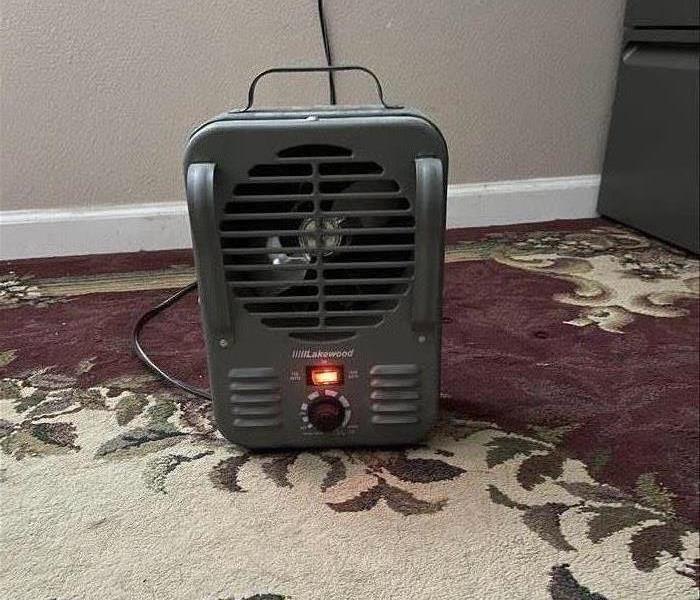 A grey space heater in an office type setting. The space heater is sitting in a safe distance away from all objects that could catch on fire.
A grey space heater in an office type setting. The space heater is sitting in a safe distance away from all objects that could catch on fire.
Winter is soon to come, and with winter it brings wind, snow, and freezing temperatures. When it’s really cold outside some offices and homes are just not as warm as you would like them. Instead of turning up the furnace, many people choose to add a space heater.
If, for some reason, your electricity goes out and you need to use a generator, you need to know all the safety measures when using one.
When using a space heater or a generator, there is more to it than just plugging it in and walking away. You need to understand all the safety precautions, such as how to prevent fires, carbon monoxide poisoning, and so much more. Here are just a few tips on what to do and not to do.
Space Heaters:
Keep combustibles at least three feet away
Use a wall outlet and never a power strip
DO NOT leave running unattended or for prolonged periods in a confined space to reduce hyperthermia hazards
Generators:
Use portable generators outside only, at least 20 feet from the home, and direct the exhaust away from the home and any other buildings.
Never use a generator inside a home, basement, shed, or garage, even with the door open.
Smoke and CO Alarms:
Install smoke alarms on every level of the home and inside each bedroom
CO alarms should be placed on every level of the home and outside sleeping areas
Test the alarms every month to make sure they are working
Wildfire Preparation
8/2/2022 (Permalink)
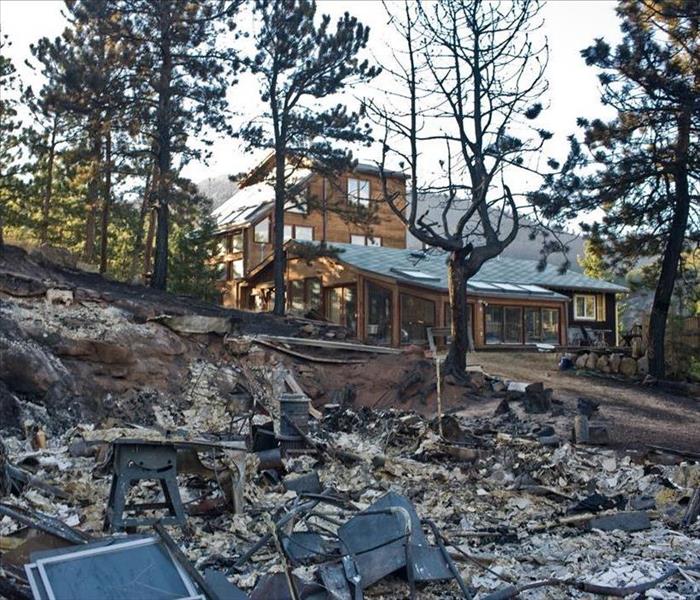 Some burnt materials, and a house that was saved by following the safety guidelines.
Some burnt materials, and a house that was saved by following the safety guidelines.
In Wyoming, our lack of summertime rain makes for very dry conditions. When the grass and weeds get dry enough, it takes very little to ignite a wildfire. It could be a cigarette that is thrown out the window, chains from trailers dragging and sparking, an unmanned fire from a camp fire, or a bolt of lightning. Any one of the these scenarios can set a wildfire, and when it’s dry, it is hard to get the fire under control.
There are a few things that can be done to help save properties from a wildfire.
Within 30 Feet -
- Clear combustible materials like pine needles, branches, and dead leaves.
- Cut down any tree limbs that are at least 15 feet from the ground. This will help prevent the spread to your property line.
- Keep any kind of vegetation off your building.
- Place flammable lawn furniture in storage when not in use.
- Use gravel instead of wood chips. Try to avoid using flammable décor.
Within 30-100 Feet -
- Cover pathways or driveways with gravel or rock. They are good materials for a “fuel break”. You want fuel breaks on your property, as they will help stop the spread of the fire.
- Cut branches that are 8 feet or closer to the ground
- Get rid of combustible vegetation
Within 100-200 Feet -
- This is where if you can store firewood or scrap wood.
- Still clear combustible vegetation
- When planting trees, keep them far apart so the branches don’t touch.
If you run into a situation that you have a fire or smoke damage from a wildfire, call SERVPRO of Casper. We will provide a free walk-through assessment on your house.
Space Heater Safety
1/28/2022 (Permalink)
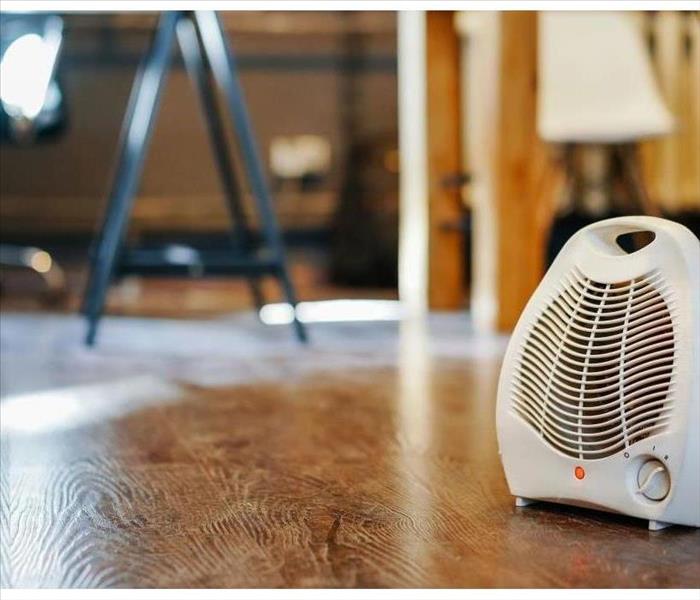 A space heater that is properly placed heating that area up.
A space heater that is properly placed heating that area up.
During the coldest months of winter, it’s not unusual to have areas in the home or office that are not adequately warmed up by your heating system. Space heaters are a common solution to adding heat to cold areas without increasing the temperature throughout the building by turning up the thermostat. But if it is used incorrectly, a space heater can create additional risks and hazards. If misused, it can cause fire or smoke damage to the property.
Following these tips this can help prevent a disaster caused by a space heater:
Make sure the heater is on a level, hard floor. Don’t place on carpets or area rugs.
Keep at least three feet away from flammable materials .
Keep away from loose fabric, such as drapes or hanging towels.
Keep out of reach of children and pets.
Always plug directly into the wall. Do not use extension cords or power strips.
Don’t leave heater unattended.
Always unplug when not in use.
Make sure there are smoke alarms on every floor of the property.
We at SERVPRO of Casper hope you have a safe and warm winter.
Fire Drills
1/6/2022 (Permalink)
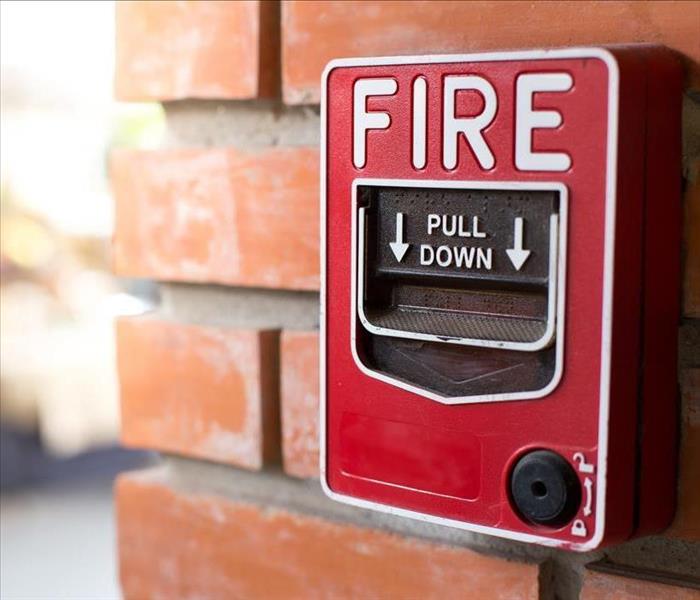 A Fire Alarm Pull
A Fire Alarm Pull
When running a business, your top priority should be the safety of your employees and patrons. Having a safety plan in place will help your employees know what to do in case of an emergency event. Doing drills such as a fire drills will help your employees know what to do and where to go if a fire should happen. Doing regular fire drills with different scenarios is important, because of the many variables that could occur. So it is best to be prepared as much as you can. When putting together an emergency plan, remember the Seven P’s (Proper prior planning and preparation prevents poor performance). There should be one person per shift that is in charge during an emergency.
For a commercial building, there should be some key points in a fire plan: You will want to establish roles and responsibilities for a fire evacuation team. Make sure there is a communication plan, such as mapping out routes. Make sure you know the locations of all fire alarms, smoke detectors, and fire extinguishers. It is best to run your employees through a fire drill at least twice a year.
When setting up standards for you fire drill, it becomes easier after the first one. You will have a better idea what needs to be done, routes, and acceptable times.
You should have goals, such as how much time does it take to shutdown critical equipment, how long does it take for everyone to get out of the building, and do a check-in. Once the first one is done, have a sit down with the leaders and have them give you a report. Then re-adjust either your goals, routes, or routines on getting out.
Once you have things established, rehearsing fire drills regularly is important. Changing the routine is important too. People can start getting complacent, so when the time comes, everyone will be on top of their game.
Appoint independent observers during drills. You want people that are not on your team to keep an eye out during a fire drill. Things they should be looking out for: large groups moving slowly and talking to each other, people using cellphones, people grabbing coats, purses, or bags, doors that are hard to open or slippery floors that could cause problems with people that have a disability, or anyone that chooses to use a different exit rather than the one close to them.
After a fire drill is done, there should be an AAR(After Action Review). Things that should be reported include: did employees close the door after exiting the room? Was everyone calm and confident? Did everyone go where they are suppose to go? Did all the alarms work properly?
Christmas Tree Safety
12/14/2021 (Permalink)
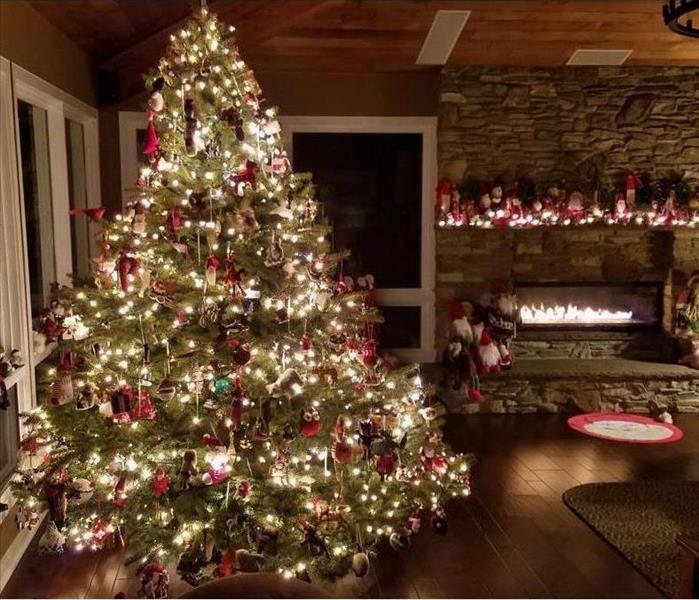 A decorated Christmas tree in a decorated living room.
A decorated Christmas tree in a decorated living room.
One of the best parts of Christmas is the Christmas tree. But there are responsibilities involved with having a Christmas tree, whether it is a natural or artificial tree. If you are purchasing a real tree, don’t just grab the first tree on the lot. Carefully inspect the tree before buying. You want to make sure the tree is fresh with green needles, and that the needles do not fall off when touched.
When placing your Christmas tree in your home, cut at least 2 inches from the base of the trunk. Once the tree is secured in its stand, add enough water to keep at least the bottom inch of the trunk submerged. You will want to add water daily, because the tree will soak up a lot of water. Make sure that your tree is at least three feet away from any heat source, like fireplaces, radiators, candles, heating vents, or lights. You want to make sure that your Christmas tree is not blocking any exits. If an emergency should happen, you don’t want to have to fight your tree.
When it comes to lighting the tree, use lights that are listed by a qualified testing laboratory. Be sure to pay attention to the details on the box, as some lights are rated for indoor or outdoor use only. Replace any strings of lights that are worn, broken, or have loose bulb connections. Read the manufacturer’s instructions for how many lights you can string together, and do not overload the lights or outlets.
Be cautious of toddlers and pets. They can pull the ornaments and lights down, and possibly put them in their mouth. The ornaments are a choking hazard, and the lights can be an electrocution hazard. You may have to set up a barrier for their safety.
After Christmas, it is good to get rid of the tree before it starts to dry out. A dried-out tree is a fire hazard. They should not be tossed in your garage, or near the side of your home.
Some facts from the NFPA (National Fire Protection Association):
- Almost one third of home Christmas tree fires are caused by electrical problems.
- Although Christmas tree fires are not common, when they do occur, they are more likely to be serious.
- A heat source too close to the tree causes more than one in every five of the fires.
Chimney Inspection
10/8/2021 (Permalink)
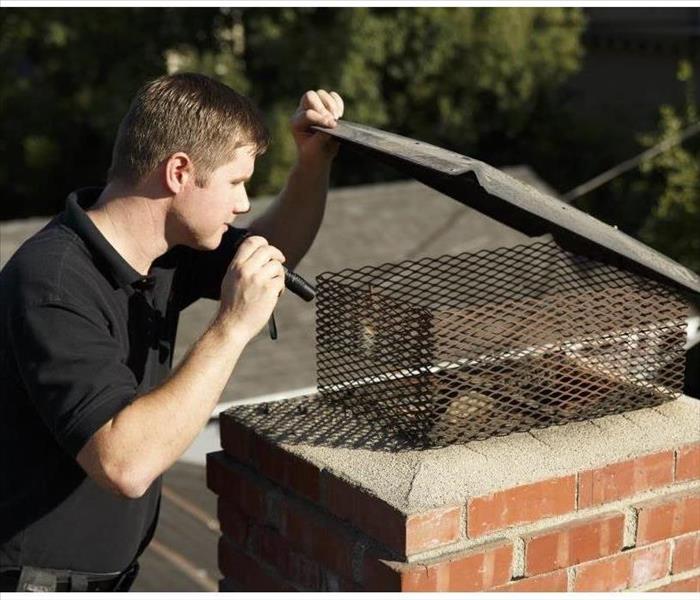 An inspector doing a chimney inspection.
An inspector doing a chimney inspection.
Nothing is more comforting on a cold day than lighting your fireplace. A fireplace has a wonderful ambience that cannot be matched by a furnace. The beautiful colors of the flames, the smell, and the feeling of the heat is enjoyable. But there is a lot of responsibility when it comes to owning a fireplace. You need to have periodic inspections, cleaning, and more. Here are some things you should do before winter.
Hire a Chimney Sweep:
The NFPA (National Fire Protection Association) recommends that all chimneys get swept at least once a year. Its best to find a certified sweep in your area to make sure it its done properly.
Check for Damage:
When you have your chimney swept, you should also request an inspection. They should look for cracks, loose bricks, or missing mortar. The chimney liners should be checked also for cracking or deterioration.
Cap the Chimney:
During the inspection looking at the chimney cap is important too. The cap helps keep out the rain, birds, squirrels, and debris from entering. If there is damage, or it is missing, make sure it is fixed or replaced.
Burn Seasoned Hardwood:
“Green” wood and certain soft woods like pine produce more creosote, a flammable byproduct of combustion that build up in the chimney. Excessive creosote buildup can cause a chimney fire. You want to burn dense hardwoods, like oak, if they are available. Before using any wood for fire, split it and store it in a high and dry place for at least six months.
Don’t Overload:
Keep your fire small. Small fire creates less smoke, and creosote that can build on the walls of your fire place. Also, if your fire gets toolarge, it can get too hot and crack the walls of your chimney.
Build it Right:
When starting a fire, start with kindling instead of flammable liquids. Place the logs towards the back, and on a metal grate.
Use a Spark Guard:
It is best if a fireplace has a glass or mesh door. This will help any shooting embers from coming out and landing on your floor. Adding a fire screen outside the fireplace creates an additional layer of protection against sparks and popping embers.
If you experience a mishap with your chimney or fireplace, prompt cleanup of the resulting smoke damage is important. Call SERVPRO of Casper for a free assessment.
A Fire Free Halloween
9/30/2021 (Permalink)
 Halloween decorations, there is carved pumpkins, skulls, and other Halloween decorations.
Halloween decorations, there is carved pumpkins, skulls, and other Halloween decorations.
Halloween is right around the corner! People will be busy with parties, trick-or-treaters, and costumes. But one the most popular traditional activities during this time is carving pumpkins. You get to carve out funny or scary faces then add a candle in them so they light up at night.
If not done properly, there can be accidents, such as fires. There are a lot of Halloween-related items and materials that could catch on fire. Children’s costumes, decorations with loose fabric, or the dried cornstalks that are a popular fall accent, can all be very combustible. With the help of the National Fire Protection Association, I’m going to give you some tips on how to prevent a fire at Halloween.
- Use battery-operated candle or glow stick in the jack-o-lantern
- When choosing costumes, avoid long trailing fabric
- Teach your children to stay away from flames, such as a jack-o-lantern with a candle
- Keep dried decorations such as flowers, cornstalks, or crepe paper away from an open flame, or even light bulbs that can heat up, such as incandescent lighting
- Keep all exits clear of decorations so the escape routes are available if necessary, and make sure all smoke alarms are working
- Provide children with flashlights or glow sticks as part of their costume
By following some of these simple tips, you can have a happy and safe Halloween!!
4th of July BBQs
7/2/2021 (Permalink)
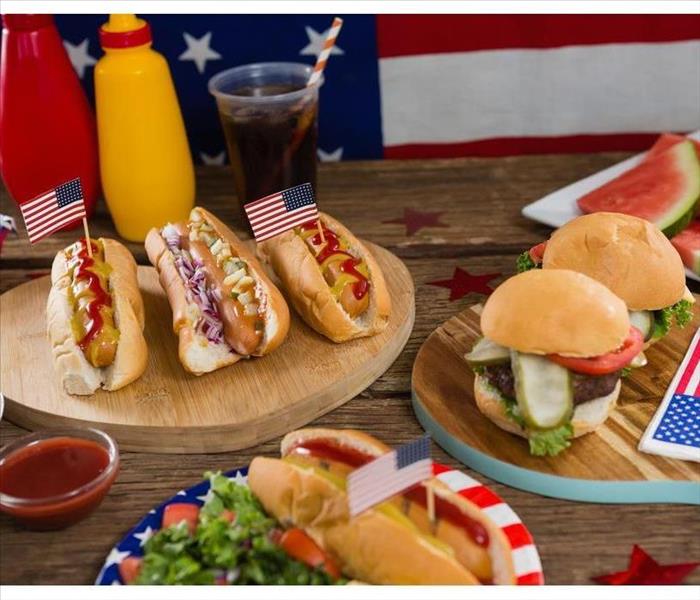 A table full of bbq food, hot dogs, and burgers.
A table full of bbq food, hot dogs, and burgers.
The Fourth of July brings Barbecues, parades, concerts, and fireworks. Everyone loves fireworks. Who doesn’t love the sounds, lights, and colors? But there are some safety concerns that you need to be aware of when handling or being around fireworks. The Consumer Product Safety Commission states that in 2018, there were 9,100 reported firework injuries and 5 deaths.
If fireworks are legal where you live and you choose to use them, here are a few safety tips:
Never allow young children to handle fireworks
Older children should use them only under adult supervision
Never use fireworks if impaired by drugs or alcohol
Anyone using fireworks or standing nearby should wear protective eyewear
Never hold lighted fireworks in your hands
Never light fireworks indoors
When using fireworks point them away from people, houses, and flammable material
Never point or throw fireworks at another person
Only light one device at a time and maintain a safe distance after lighting
Never ignite devices in a container
Do not try to re-light or handle malfunctioning fireworks
Soak both spent and unused fireworks in water for a few hours before discarding
Keep a bucket of water nearby to fully extinguish fireworks that don’t go off or in case of fire
Never use illegal fireworks
Another 4th of July favorite is the sparkler. There is a misconception that they can’t hurt you because they don’t shoot off in the sky, but they can. The National Fire Protection Association states that sparkler injuries make up 25% of fireworks-related emergency room visits. Sparklers burn at 2,000 degrees Fahrenheit. That is hot enough to melt metal. If dropped on clothing, it can catch them on fire. It can also cause severe burns to the feet if wearing sandals, or if you are barefoot. Glow sticks, confetti poppers, and colored streamers are safer alternatives to sparklers.
We at SERVPRO of Casper hope you and your family have a fun and safe Fourth of July!
Burning Candles 1 of 2
1/22/2021 (Permalink)
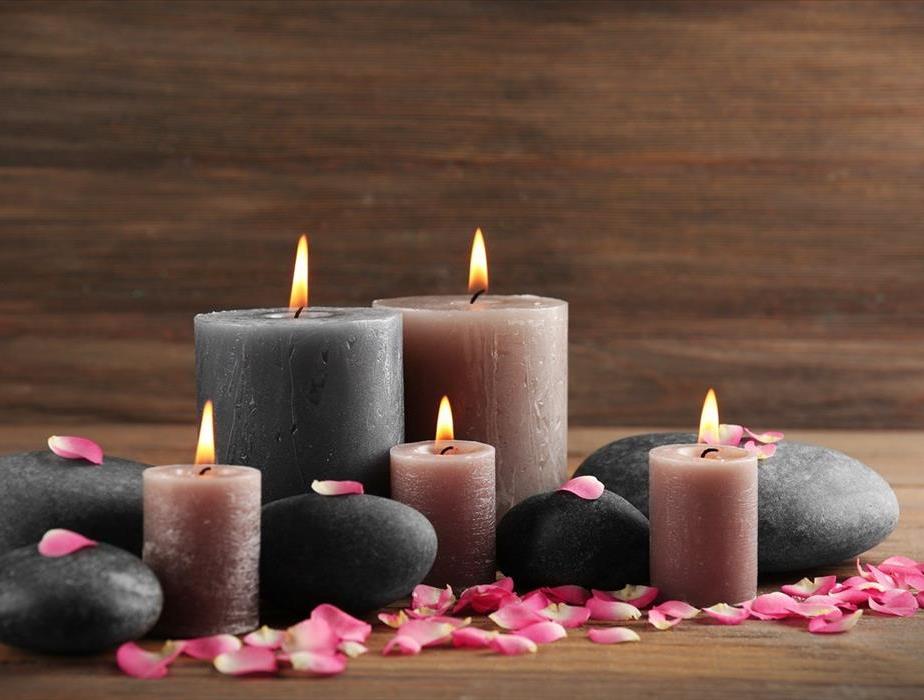 Gray and purple candles that are lit.
Gray and purple candles that are lit.
There are a lot of beautiful things that candles bring to a room in a house. They bring a nice ambiance, they are beautiful, and they can smell good. But candles carry an inherent risk: they can cause injures, and possibly a house fire.
Here are the statistics from the National Fire Protection Association. In a 5 year period (2013-2017):
Candles caused 2% of reported home fires, 3% of home fire deaths, 6% of home fire injuries, and 4% of the direct property damage in home fires.
Roughly one-third (37%) of home candle fires started in bedrooms. These fires caused 33% of the associated deaths and 51% of the associated injuries.
Falling asleep was a factor in 11% percent of the home candle fires and 19% of the associated deaths.
On average, 22 home candle fires were reported per day.
Three of every five (60%) of home candle fires occurred when some form of combustible material was left or came too close to the candle.
December is the peak time of year for home candle fires. In December, 12% of home candle fires began with decorations compared to 4% the rest of the year.
With those statistics in mind, here are some suggestions on how to burn candles safely:
Before lighting:
Always trim the wick to ¼ inch. Long or crooked wicks can cause flaring, dripping or uneven burning.
Keep the wax pool clear of debris, matches, and wick trimmings.
Make sure you have a candle holder designed for that specific candle. It needs to be heat resistant, sturdy, and large enough to contain drips.
Burn Candles in a well-ventilated room:
Stay away from drafts, vents or air currents. By doing that it will help uneven burning, sooting, and excessive burning.
It is recommended that candles do not burn longer than 4 hours, and cool at least 2 hours before relighting.
It is best to use long matches or a long lighter. Keep hair and loose clothes away from the flame.
Burning Candles 2 of 2
1/22/2021 (Permalink)
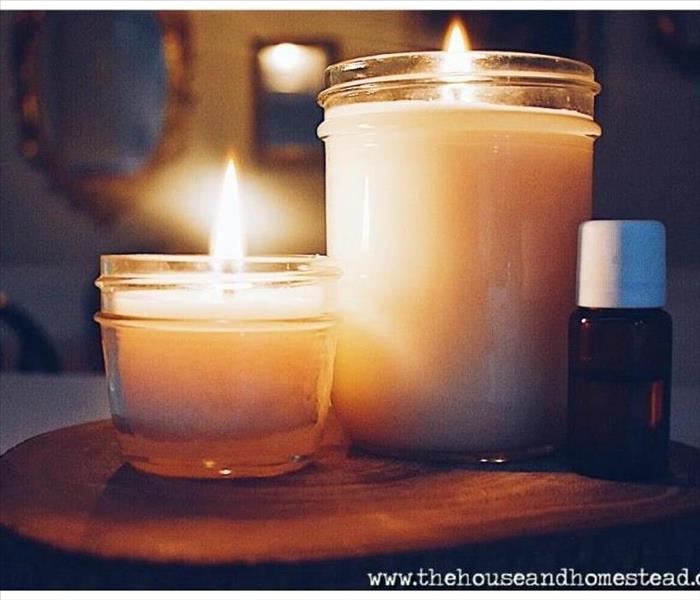 Lit candles in mason jars.
Lit candles in mason jars.
Burning Candles 2 of 2
While Burning:
Never leave candles unattended.
Keep burning candles away from furniture, drapes, bedding, carpets, books, paper, decorations, etc.
Keep candles out reach of children and pets.
Don’t touch or move a candle while it is lit and the wax is liquefied.
If using a pillar candle, don’t burn the last 2 inches; for any other type, don’t burn the last ½ inch.
If burning multiple candles, burn them at least 3 inches apart.
If the flame becomes too high or flickers repeatedly, extinguish the flame.
Never use a candle as a night light, just in case you fall asleep.
Be aware if using candles during power outages. Try having flashlights on hand. It is safer to move a flashlight around than a lit candle.
When Extinguishing a Candle:
To help prevent wax splattering when extinguishing a lit candle, use a candle snuffer.
Don’t use water to snuff out the candle. The hot wax may splatter, and the glass might break.
Make sure the candle is completely snuffed out before leaving the room. Really look at the wick and make sure there are no active embers on the tip.
It is best not to move or handle the candle until it is cooled and the wax has hardened.
If you use a knife or something metallic to scrape wax drippings off of a holder, you may end up scratching the glass, and it can become weak and break. A plastic or wood scraper is safer.
Following these guidelines, you can enjoy candles, while still keeping yourself and your home safe.
Do's and Don'ts of Fire Damage Clean Up
12/28/2020 (Permalink)
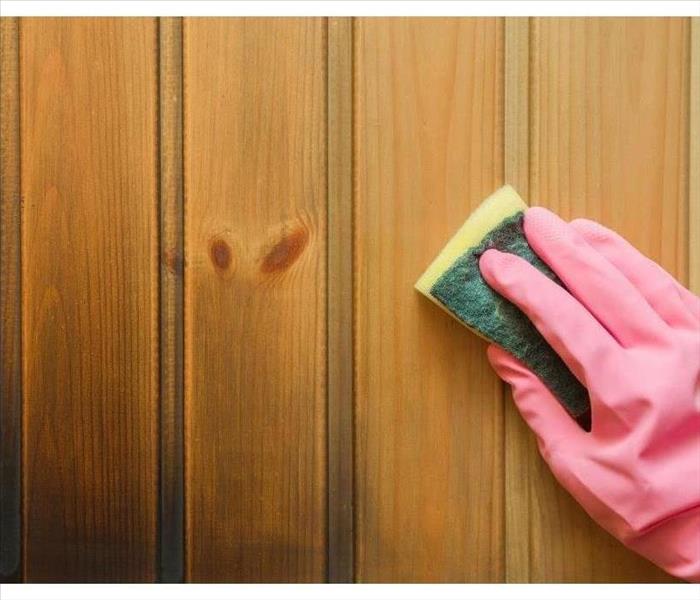 Wall cleaning after a fire/smoke damage.
Wall cleaning after a fire/smoke damage.
When a fire happens in your home, it’s a scary moment. After your home has been released, and you are allowed to re-enter it, seeing the damage for the first time can be shocking. Your first instinct is to start touching damaged items, and attempting to clean them. But we advise highly against that, as it can cause more damage by doing so. There is a lot to know when it comes to a fire clean up. To help, I’m going to provide a list of Do’s and Don’ts.
Do:
- Wear gloves before touching anything. Oils in your hands can permanently set soot.
- Limit movement in the house to prevent particles from being embedded into upholstery and carpet.
- Place dry, colorfast towels or old linens on rugs, upholstery, and carpet traffic areas.
- If the electricity is off, empty freezers and refrigerator completely. Prop doors open to help prevent odor.
- Wipe soot from chrome on kitchen and bathroom faucets, trim, and appliances. Then protect these surfaces with a light coating of lubricant.
- If heat is off during the winter, pour RV antifreeze in sinks, toilet bowls, holding tank and tubs to avoid pipe and fixture freezing.
- Wash both sides of your house plant leaves.
- Change the HVAC filter. Leave the system off until a trained professional checks the system out.
- Tape double layer of cheesecloth over air registers. This stops particles of soot from getting in the HVAC system.
Don’t:
- Attempt to wash any walls or painted surfaces until you talk to a SERVPRO professional.
- Attempt to shampoo carpet or upholstered furniture without consulting with a SERVPRO professional.
- Attempt to clean any electrical appliances. They may have been close to the fire, heat, or water source.
- Consume any food or beverages that may been stored close to a fire, or heat source.
- Turn on ceiling fixtures if the ceiling is wet. The wires may be wet or damaged and it could cause electrical shock. Air movement may cause secondary damage.
- Attempt to clean smoke-damaged laundry. If sending garments to a dry cleaner, make sure they specialize in fire/smoke damaged materials.
SERVPRO of Casper is here for you, to help you during your difficult time. We are trained and certified to assess and restore your loss. Call us at 307-235-6558 for your free evaluation.
Fire Pet Safety
7/23/2020 (Permalink)
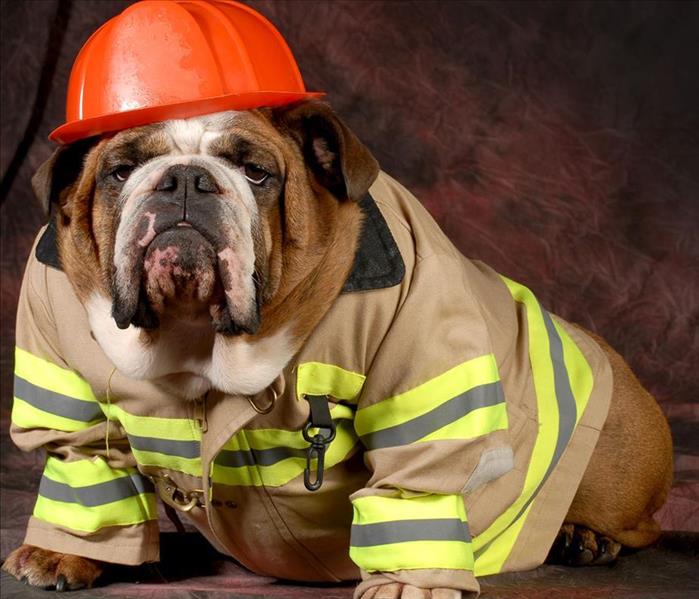 A dog in a fire fighters uniform
A dog in a fire fighters uniform
When a fire happens at your home, it can be devastating. Your first thought is to get your family (including your pets) and get out. But what if you’re not home and there’s a fire? There are 40,000 pets that die every year from a house fire, and about 1,000 home fires are accidentally started by house pets.
Prevent Your Pets from Starting Fires:
- Extinguish Open Flames – Pets are curious critters, and they want to snoop and investigate everything. They want to check out the cooking appliances, candles, and even your fire place. It’s recommended that you don’t leave your pet unattended in any areas that have an open flame. Make sure everything is snuffed out and turned off before leaving your home.
- Remove Stove Knobs - Before you leave your home, consider removing the knobs from your stove or putting a cover over them. The stove or cooktop is the most common piece of equipment involved in fires started by pets.
- Invest in Flameless Candles – Flameless candles have use an electronic light bulb instead of an open flame. If it gets knocked over, there is no risk of it starting a fire. Cats are notorious for starting fires with their tails from knocking over candles.
- Secure Young Pets – Young pets, like babies, are still learning what is right and what is wrong. Until they have learned what to stay away from, it is best to keep them away from potential hazards by containing them with kennels or baby gates.
Help Firefighters Help Your Pets:
- Keep collars on your pets, and keep their leashes close to the front door so it’s ready in case the firefighters need to save your pets. Keep them contained in a room or area that’s near the front door so it’s easy to find them.
- Put a Pet Emergency Alert sticker in the front window by the door. On the sticker, you list how many pets and what kind of pets you have, and names. This will help the firefighters know what kind of animal and how many to look out for.
The best way to protect your pets from a fire is to include them in your family plan. This includes making them their own disaster supply kit, and pre-arranging a safe place for them to stay if you should have to leave your home. When you practice your escape plan include your pets, so they will come to you when they are called. If something should happen and you must evacuate it’s important to protect them, but remember if you are struggling to get them out, don’t delay too long in getting yourself and your family out.
Tips on Extinguishing a Grease Fire
6/1/2020 (Permalink)
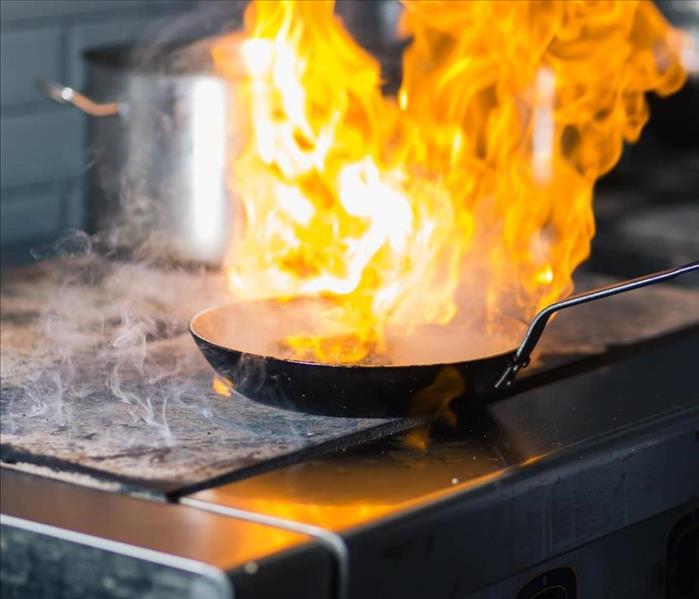 A pan that caught on fire from grease.
A pan that caught on fire from grease.
Cooking is the number one cause in home fires and injuries. Annually, there are 160,000 cooking fires caused by ignition of food or cooking materials.
Knowing how to smother a grease fire can help keep you, your family, or friends from getting hurt or having a severe house fire.
If A Grease Fire Starts:
- Cover the flames with a metal lid or cookie sheet. Leave the cover on until it has cooled.
- Turn off the heat source.
- If it’s small and manageable, pour baking soda or salt on it to smother the fire.
- As a last resort, spray the fire with a Class B dry chemical fire extinguisher.
- Do not try to extinguish the fire with water.
- Do not attempt to move the pot or pan outside.
DO NOT use flour, baking powder, or other cooking powders that resemble baking soda or salt. They act differently, and could make the fire worse.
If You Are Unable To Extinguish The Grease Fire:
- GET OUT!! You need to leave as soon as possible to prevent injury or loss of life
- When you leave, close the door behind you. This will help contain the fire inside.
- When you get to a safe distance from the fire, call 911 right away.
- Don’t re-enter your home until it has the “all clear” from the fire department.
Tips To Prevent Grease Fires:
- Stay in the kitchen while you’re cooking. One of the leading causes of kitchen fires is unattended cooking.
- Don’t cook if you’re exhausted or inebriated.
- Keep anything that can catch on fire away from your stovetop.
- Remove as much moisture from the food, and don’t add frozen foods to hot oil.
- Keep an eye on the temperature of your oil. If you see smoke or smell oil, that means your oil is too hot. Turn off the burner and let it cool down.
- Heat the oil slowly.
- Add food gently, so there is no splashing.
- Keep a lid in arms reach in case of a fire.
- Always keep children and pets away from the stove while cooking.
Inventorying Your Fire Loss
2/26/2020 (Permalink)
 Inventorying Your Fire Loss
Inventorying Your Fire Loss
How to complete a total loss inventory list after a house fire
If you have a major fire that destroys your home, you will have to start the contents inventory process. Documenting your personal property will be necessary to ensure you get fully compensated for what you lost. Doing this full inventory is a high-stress task, but it must be done correctly and accurately. It is important to know ahead of time that the inventory process will be messy, time-consuming, and will require a lot of patience. You will be documenting a large portion of your family’s life, which can be emotionally difficult.
Before entering your home after a fire, you should always get permission from the fire department. They need to confirm that the scene has been released, and is no longer being investigated. When you have approval to enter your home, you want to make sure that you are wearing the proper protective gear. A long-sleeved shirt, long pants, close-toed shoes or boots, work gloves, hard hat, and safety glasses can help protect you from hazards. A disposable respirator with a NIOSH rating of N95 will help protect your respiratory system from inhaling ash, soot, and other toxic materials that may be present in the air.
- Start the inventory by making a diagram of your house and label all the rooms. In the rooms start drawing big furniture, and electronics. By doing this it will help jump start your brain into remembering what was in the rooms.
- Start one room at a time. Gather your smaller stuff. Place them on flat surfaces like some sort of tabletop. This is so you can get a good picture of your items. Make sure you do this with all the items so you have photos for everything. Once that room is done, then it’s time to move on to the next.
- When you are done photographing, then it’s time to start making your list. You will want to include brand, age, quantity, cost and condition. Model numbers and serial numbers, when available, should be documented. You need to be specific as possible to make sure you get the proper compensation.
- Note the price you paid for each on your inventory sheet, and include the receipts, if available. If you can’t remember what the value of an item is, sometimes you can research the valuation on the internet. If you find a price on the internet, be sure to note the cost to replace your damaged item with a new item of like kind and quality.
Fire Place Maintenance
2/24/2020 (Permalink)
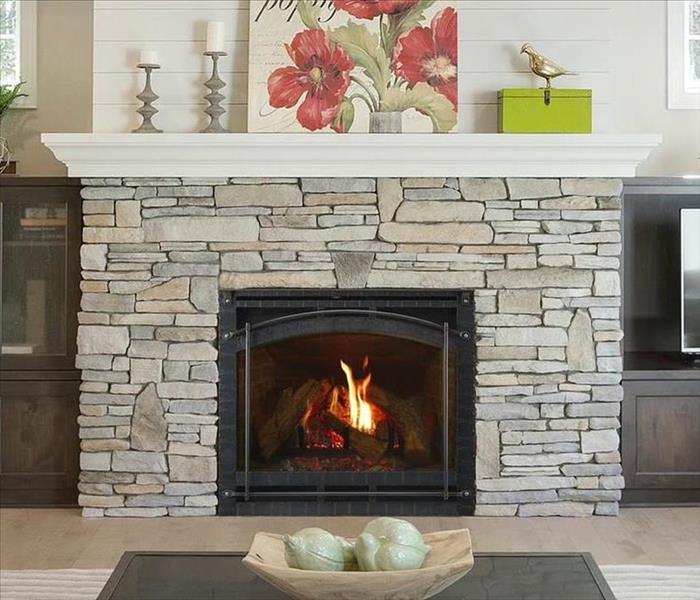 A fireplace with burning wood. Keeping the room nice and warm.
A fireplace with burning wood. Keeping the room nice and warm.
When your home has a fireplace, there is a lot of responsibility in maintaining it. Before you use it, make sure it is in good working order, and cleaned out properly. If it’s not maintained regularly, it could cause a structure fire, smoke could puff back in the house, or it could cause carbon monoxide poisoning. We’ll provide a few easy steps to take to make sure your fireplace is safe.
- Your chimney should be swept inside at least once a year, and it should be at the beginning of the year. By sweeping the chimney, it will help remove soot and debris. When you’re sweeping you should look for any animals that may have crawled in and died.
- Before you start the fire, check the structure of your chimney. You want to make sure there are no cracks, loose bricks, or missing mortar. Also look for any deterioration. Cracks and spalling are signs of deterioration.
- Use a wire-mesh cap on top of the chimney to keep the birds, squirrels, rain and other debris from entering.
- Check the damper; the damper is a movable plate that sits above the fireplace before the flue. Make sure the damper is working properly. There should be no debris preventing it from opening and closing.
- When cleaning the chimney, you want to keep an eye out for creosote buildup. Creosote is a chemical mass of carbon formed when wood, tar or fossil fuels are burned. Even though you can’t see it from the outside doesn’t mean that the buildup is not on the inside. When it’s not properly removed, it can build up in the flue and chimney, potentially causing a chimney fire.
- Make sure there isn’t anything hanging over the chimney, such as tree limbs, flags, etc. They could be a fire hazard, and it could interfere with proper draft airflow.
- Clean out ashes regularly. You should clean out the ashes from the last time you ran your fireplace. You can simply sweep or vacuum the cold ashes and dispose of them. Be aware that there could be hot coals in the mix. Hot coals can stay hot for up to 3 days.
If you don’t have experience in cleaning or maintaining your fireplace or know what to look for, call a local professional. They have the tools and resources to make sure that your chimney is up and running safely for the winter time.
Fire Sources To Watch Out For
2/24/2020 (Permalink)
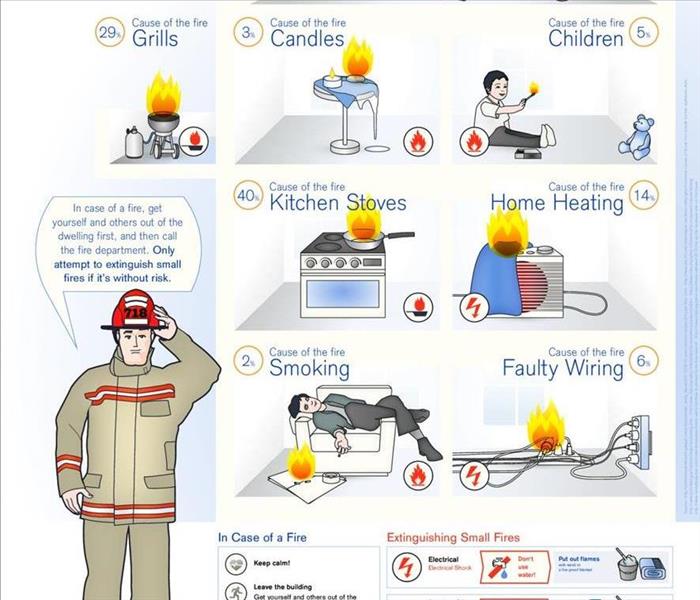 Pictures of some of the main sources of fires.
Pictures of some of the main sources of fires.
Whether you live in a house, trailer, or an apartment, you are always at risk for a fire, or smoke damage. It’s a good idea to know what some of the main sources are.
- Cooking equipment – Cooking is one of the leading causes of house fires. When you get a pan of oil or grease too hot on the stove, it makes it very flammable and it can flash. Holiday cooking is another cause. When cooking during the holidays you’re preparing multiple dishes at once, while entertaining guests at the same time. If you’re not paying attention, a simple mistake such as laying a towel too close to the stove flame can cause a fire. Another source would be kitchen appliances, such as crockpots, toasters, and griddles. An electrical short from a damaged cord, or putting a hot appliance away before it has fully cooled, can cause damage.
- Candles – If a candle is allowed to burn too closely to curtains or flammable items, they could catch on fire. Also, leaving candles burning unattended can lead to a mishap.
- Smoking – If a cigarette or cigar is not completely snuffed out, the embers could still be a risk to ignite a fire.
- Children playing with fire – Most children are curious with fire, and what can cause it. They see someone light a match, or a lighter, or even the gas stove, they want to get ahold of it and light it themselves. Because they don’t understand the risk of what could happen, sometimes an accidental fire can happen.
- Barbeque – During the summer, there is a lot more outdoor cooking. Most outdoor cooking is done on a gas appliance, or using a charcoal or wood fire. You never want to leave a grill unattended on a wooden porch. And it is important to avoid grilling too closely to a house or fence.
- Wiring – When it comes to the wiring in your home, you don’t want to take any short cuts. It should be up to date, and installed by a professional. Overheating or an electrical short can quickly start a fire inside the walls of your home.
- Christmas tree – The Christmas tree is everyone’s favorite, whether it’s a real tree or artificial. If it’s a real tree, you want to make sure that the stand is full of water so the tree doesn’t dry out. With both artificial and natural trees, placing them too close to a heat source (such as a fireplace or baseboard heater) can be a fire hazard.
- Heating Equipment – During winter, it is a common practice to use a space heater to warm up a cold area in a house, or to add heat to a garage. It is critical that space heaters are kept a safe distance from any combustible materials. Walls, clothes, curtains, and furniture can ignite if they are too close to a space heater. The same holds true for electric baseboard heat registers. A safe radius of at least six inches from the front and sides of the unit should be kept clear of any combustible materials.
Some fires are accidental and beyond your control. But most can be easily prevented through basic safety precautions. Always be aware of the steps you can take to prevent a fire.
Smoke Alarm Maintenance
12/27/2019 (Permalink)
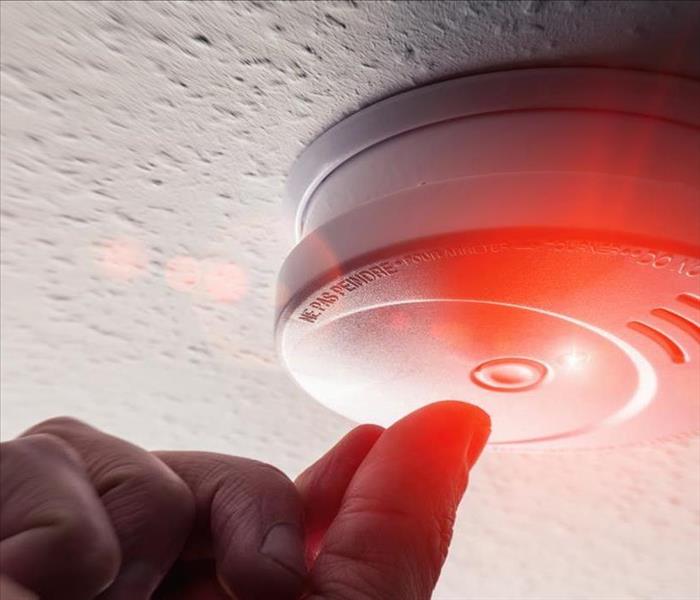 Someone is testing their smoke alarm.
Someone is testing their smoke alarm.
Smoke alarms are a fairly low-maintenance household device. However, in order to ensure they are in good working order, there are a few steps that you should perform.
- Make sure you read the manufacturer’s instructions to learn about any special maintenance required for your specific alarm model.
- It is recommended that you test the smoke alarm at least once a month. Normally, this is done by pressing the test button on the center of the device.
- Make sure everyone is familiar with the sound of the alarms, and knows what to do if they hear the alarm.
- The batteries in the smoke alarms should typically be replaced twice a year. A good habit is to change the batteries at the beginning and the end of Daylight Savings Time. If one of your alarms starts to occasionally “chirp”, it means the battery is low and you need to replace it immediately.
Always follow the manufacturer’s recommendations for your smoke alarms, and never become complacent in their upkeep. With a little periodic maintenance, smoke alarms can save lives.
Space Heater Safety
12/26/2019 (Permalink)
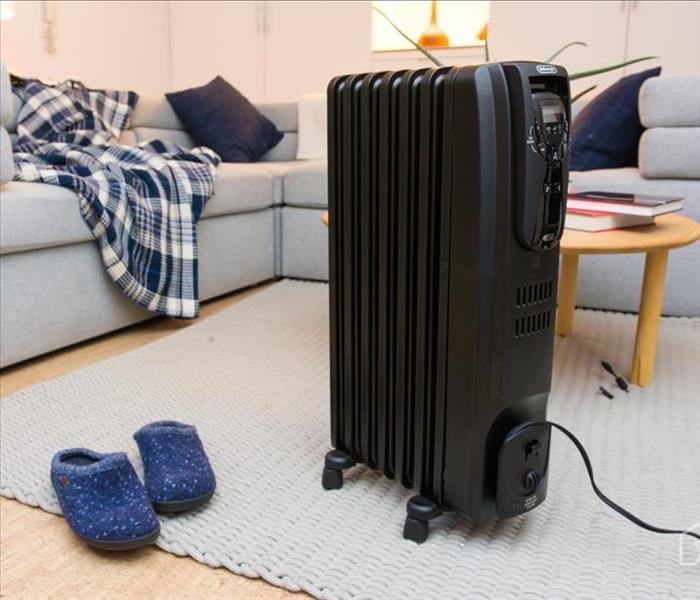 A Space heater sitting in the middle of the living room. There is a couch, slippers, and a coffee table sitting behind it. .
A Space heater sitting in the middle of the living room. There is a couch, slippers, and a coffee table sitting behind it. .
When outdoor temperatures drop, some people use space heaters to add a little extra heat in their home or room. There are more than 65,000 fires that are caused by heating equipment annually. With those fires, thousands of injuries, hundreds of deaths, and millions of dollars in property damage occur. These fires are often started by heaters placed too close to combustible materials, being improperly plugged in, or simply being improperly utilized.
Safety should be everyone’s top concern when it comes to space heaters. Here are some safety tips to keep you and your family safe.
- Turn it off when you’re leaving the room or going to sleep.
- Don’t let pets or children play close to the heater.
- Make sure your space heater has a recognized laboratory testing sticker on it.
- Take the time to read the instructions and warning labels.
- A space heater is only a supplemental heater, not a source to heat your bedding, cook food, dry clothes, or thaw pipes.
- Must keep the heater at least 3 feet away from anything that can catch on fire.
- Place the heater flat on the ground. Never place them on cabinets, furniture, carpet, or any surface that can catch on fire.
- Always plug the heater straight into the outlet, never into an extension cord or power strip.
- When you are done using the heater, unplug it and put away in a safe location after it has fully cooled.
We here at SERVPRO of Casper hope you have a warm and safe winter!
Fire Extinguisher Safety
11/19/2019 (Permalink)
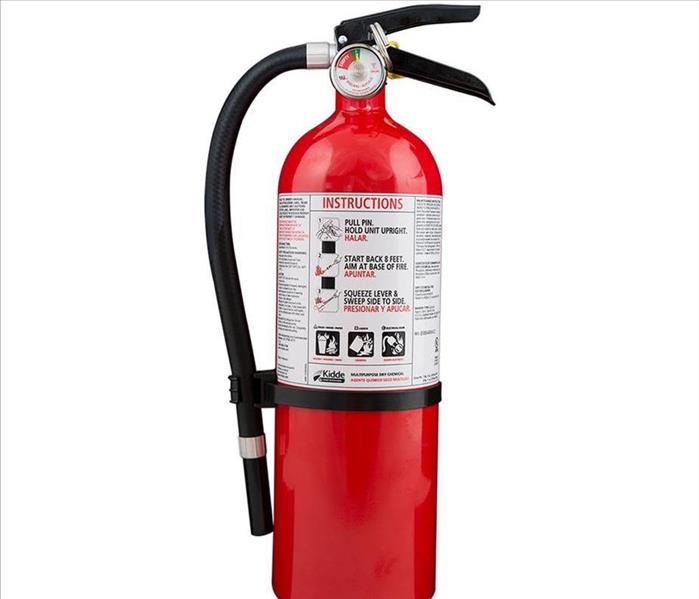 A red fire extinguisher
A red fire extinguisher
Having fire extinguishers in your home or commercial building is an important safety measure. But it is equally important to select the right type of fire extinguisher, and to know how to utilize it effectively.
To operate one, just remember the word PASS.
Pull the pin. Hold the extinguisher with the nozzle pointing away from you, and release the locking mechanism.
Aim low. Point the extinguisher at the base of the fire.
Squeeze the lever slowly and evenly
Sweep the nozzle from side-to-side
- When selecting a fire extinguisher for the home, it is best to pick a multi-purpose extinguisher (Class ABC). The multi-purpose extinguisher is good for all kinds of house fires.
- Make sure there’s a label on it from an independent testing laboratory.
- Familiarize yourself with the fire extinguisher by reading the instructions that come with it. Hands-on training is also available for the proper use of extinguishers. Fire equipment distributors often provide this training. And you can always check with your local fire department to see if they can help with training.
- Know when it’s time to go. A fire extinguisher is only designed to extinguish small areas like the wastebasket. Your primary concern is getting everyone out safe.
- Make sure you have an emergency plan in place. Also make sure everyone knows the exits, and where the meet-up location will be.
A fire can happen at any time, in both residential and commercial settings. Having a fire extinguisher available, and knowing how to effectively use it, can save both property and lives.
Wild Fire Preparation
6/12/2019 (Permalink)
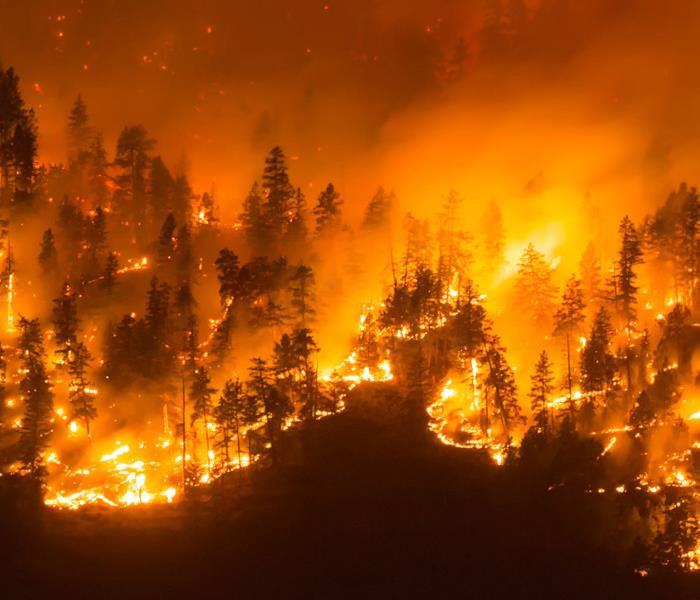 Wild Fire
Wild Fire
Towards the end of the summer, Wyoming always run a risk of wildfires. It could be caused by human error, or mother nature. A wildfire is potentially just as dangerous as flooding, and should be taken seriously.
If you’re under a wildfire warning, get to safety right away.
- Leave if told to do so
- If trapped, call 911
- Listen for emergency information and alerts
- Keep NIOSH N95 masks on hand to use to help keep particles out of the air you breathe
If you’re in a high risk area, you should prepare now.
- Sign up for your community warning system
- Have a plan for pets and livestock
- Find different shelter locations
- Gather emergency supplies, including a NIOSH N95 mask. Make sure you have a list of medications and a treatment plan, and don’t forget your pets.
- Close all doors and windows, and set up a portable air filtration machine to keep the pollution levels down in your home.
- Keep important documents in a fireproof container, and stored in a safe place, and make sure you have password-protected digital copies.
- Make sure you know where the outdoor water source is, and hook up a hose that can reach any area of your property.
- Make sure you create a fire-resistant zone free of debris such as leaves, tree branches, or flammable materials for at least 30 feet from any structure.
- Review your insurance coverage, make sure it’s all up to date and you have enough to replace your property if need be.
Survive during a wildfire
- Evacuate immediately if the authorities tell you to.
- If trapped, call 911 and give them your location, and turn on lights to help rescuers can find you
- Use NIOSH N95 masks to protect your respiratory system.
- If you are not forced to evacuate, and the condition keeps getting smokier, stay inside where it’s safer.
The after care
- Check with authorities before going back to your property, and to make sure your water is safe to drink.
- Be cautious walking around and moving things that have been burnt. There could be heat pockets, and you could get burned or start another fire. Also be considerate about your animals walking on anything that has been burned by the fire.
- Make sure you reach out to your family through text or social media. Phone lines may be over loaded because of the disaster.
- Document property damage and take photos. Make a list of anything that was destroyed and call your insurance company.
Fire pit safety
5/23/2019 (Permalink)
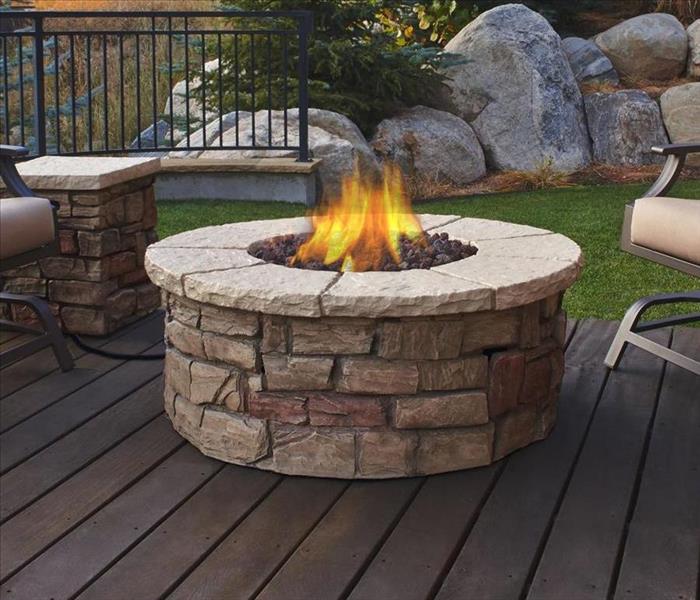 Don't have your summer ruined by your fire pit.
Don't have your summer ruined by your fire pit.
When summer arrives, you may get excited about the idea of relaxing by the fire pit in your backyard, enjoying the warm glow of a fire. But there can be safety concerns if it is not placed in the right area, or if the fire pit is not built properly. Here is a list of Do’s and Don’ts to make sure that you have a fun summer with your fire pit.
Do: Make sure your surface is level before building your fire pit. It reduces the risk of a log rolling out of the pit.
Do: Build your fire pit at least 10 feet from your home, fences, trees, and bushes. Building it closer increases the risk of fire damage.
Do: Make sure your guests keep a proper distance from your fire pit. Keep a close eye on children and pets.
Do: Check the weather forecast before building a fire, to ensure that it will not be excessively windy. You don’t want wind-driven embers or flames spreading to your trees, bushes, or home.
Do: Once you’ve extinguished your fire, gently stir the ashes to until they are cooled down.
Don’t: Don’t start your fire using gasoline or lighter fluid, if avoidable. A fire started with liquid accelerants can easily get out of control. When possible, use dry kindling instead.
Don’t: Don’t use river stones in the construction of your fire pit. Smooth stones from the river may have absorbed moisture over time, and when they are heated quickly, they can explode. It is best to use dry, rough stones.
Don’t: Don’t leave a fire unattended. Having someone present with the fire at all times ensures that if the fire starts to spread outside the pit, it can quickly be extinguished.
Dryer duct cleaning tips
4/17/2019 (Permalink)
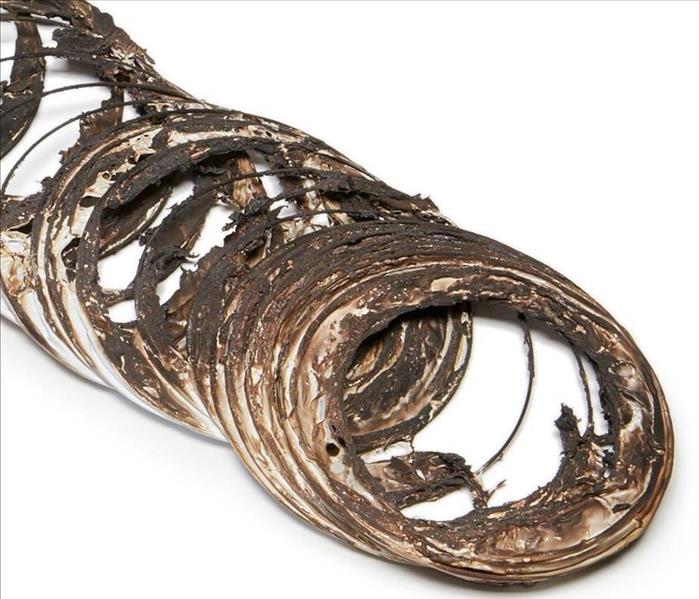 Melted dryer duct from a fire caused by back up dryer lint
Melted dryer duct from a fire caused by back up dryer lint
When most people think about duct cleaning, they often don’t think about the exhaust vent for their dryer. It’s just as important to make sure those get cleaned out. In some ways, the dryer vent is even more important than the HVAC system. Here are 5 reasons why your dryer vents should be cleaned.
- Safety
Dryers run hot, and lint is highly flammable. This can be a dangerous combination. According to the US Fire Administration, clothes dryers are responsible for more than 15,000 structure fires each year, and 80% of those are due to clogged dryer vents.
- Low-Efficiency
A clogged dryer vent could mean your clothes will need multiple cycles before drying correctly, or will need to run longer. This means that the proper amount of hot air is not reaching your dryer. Multiple cycles and extended drying times mean additional energy spent and could lead to an increase in your electrical bill.
- Mold
The purpose of the dryer vent is to release moisture and hot air outside. The moisture can sometimes create wet spots inside the tube. Built-up lint can get caught in these wet spots and create mold.
- Less Maintenance
Like any other appliance or machine your dryer will last longer and work better if it’s properly cared for. Cleaning the vent regularly will help ensure that your clothes are being dried in a timely manner and you aren’t unnecessarily wasting energy. Extended drying times can even cause strain on your fabrics. A dryer that continues to run with clogged vent can cause internal problems and require repairs. This means more money out of your pocket, and your household budget.
Your dryer vent should be cleaned once a year. If you’re unsure of how to clean your vents or want professional assistance, contact SERVPRO of Casper today!
Fire Safety for Pets
3/19/2019 (Permalink)
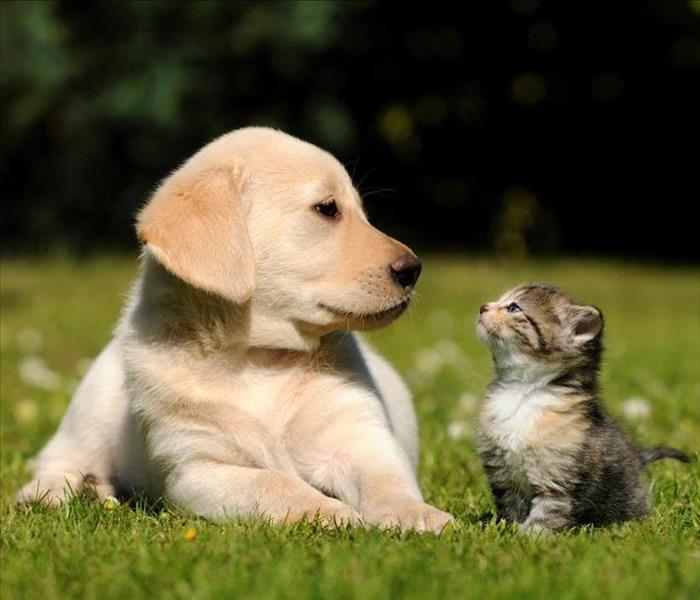 Pet Safety
Pet Safety
The best way to protect your pets from the effects of a fire is to include them in your family plan. This includes having their own disaster supplies kit as well as arranging in advance for a safe place for them to stay if you need to leave your home. When you practice your escape plan, practice taking your pets with you. Train them to come to you when you call. In the event of a disaster, if you must evacuate, the most important thing you can do to protect your pets is to evacuate them, too. But remember: never delay escape or endanger yourself or family to rescue a family pet.
Prevent Your Pets from Starting Fires
The National Fire Protection Association estimates that nearly 1,000 homes fires each year are accidentally started by the homeowner’s pets.
The American Kennel Club and ADT Security Services have joined forces to provide the following tips:
Extinguish Open Flames – Pets are generally curious and will investigate cooking appliances, candles, or even a fire in your fireplace. Ensure your pet is not left unattended around an open flame and make sure to thoroughly extinguish any open flame before leaving your home.
Remove Stove Knobs – Be sure to remove stove knobs or protect them with covers before leaving the house – a stove or cook top is the most common piece of equipment involved in a pet starting a fire.
Invest in Flameless Candles – These candles contain a light bulb rather than an open flame, and take the danger out of your pet knocking over a candle. Cats are notorious for starting fires when their tails turn over lit candles.
Secure Young Pets – Keep them confined away from potential fire-starting hazards when you are away from home such as in crates or behind baby gates in a secure area.
HELP FIREFIGHTERS HELP YOUR PETS
Keep pets near entrances when away from home. Keep collars on pets and leashes at the ready in case firefighters need to rescue your pet. When leaving pets home alone, keep them in areas or rooms near entrances where firefighters can easily find them.
Utilize a pet alert window cling. Write down the number of pets inside your house and attach the static cling to a front window. This critical information saves rescuers time when locating your pets. Make sure to keep the number of pets listed on them updated.
Source: American Red Cross
Extension Cord Safety
3/19/2019 (Permalink)
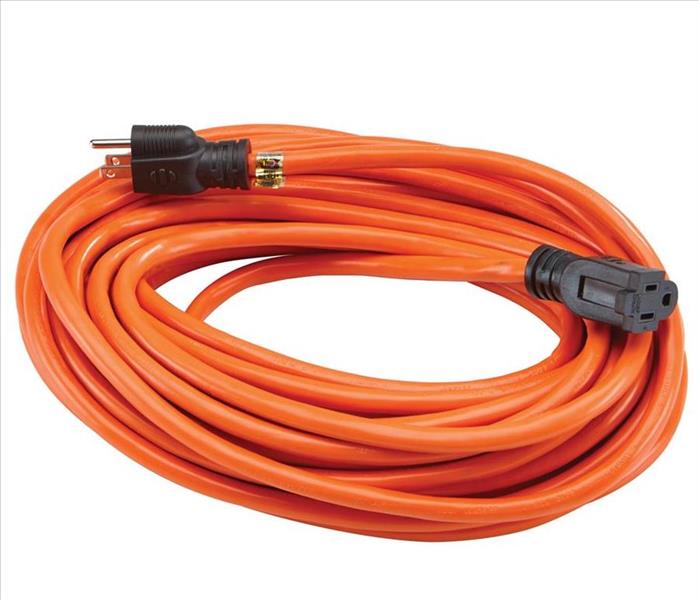 Extension Cord Safety
Extension Cord Safety
Using extension cords properly is critical to your safety. With continuous use over time, an extension cord can deteriorate, creating a potentially dangerous electric shock or fire hazard. The Electrical Safety Foundation International offers the following tips for staying safe from electric shock and electrical fires.
- Do not overload extension cords or allow them to run through water or snow on the ground
- Do not substitute extension cords for permanent wiring
- Do not run through walls, doorways, ceilings or floors. If cord is covered, heat cannot escape, which may result in a fire hazard.
- Do not use an extension cord for more than one appliance
- A heavy reliance on extension cords is an indication that you have too few outlets to address your needs. Have additional outlets installed by an electrician where you need them.
- Multiple-plug outlets must be plugged directly into mounted electrical receptacles; they cannot be chained together.
- Make sure the extension cord or temporary power strip you use is rated for the products to be plugged in, and is marked for either indoor or outdoor use.
- The appliance or tool that you are using the cord with will have a wattage rating on it. Match this up with your extension cord, and do not use a cord that has a lower rating.
- Never use a cord that feels hot or is damaged in any way. Touching even a single exposed strand can give you an electric shock or burn.
- Never use three-prong plugs with outlets that only have two slots for the plug. Do not cut off the ground pin to force a fit. This defeats the purpose of a three-prong plug and could lead to an electrical shock. Never force a plug into an outlet if it doesn’t fit.
- Use extension cords with polarized and/or three-prong plugs.
- Buy only cords approved by an independent testing laboratory, such as Underwriters Laboratories (UL), ETL-SEMKO(ETL) or Canadian Standards Association (CSA).
Carbon Monoxide
2/6/2019 (Permalink)
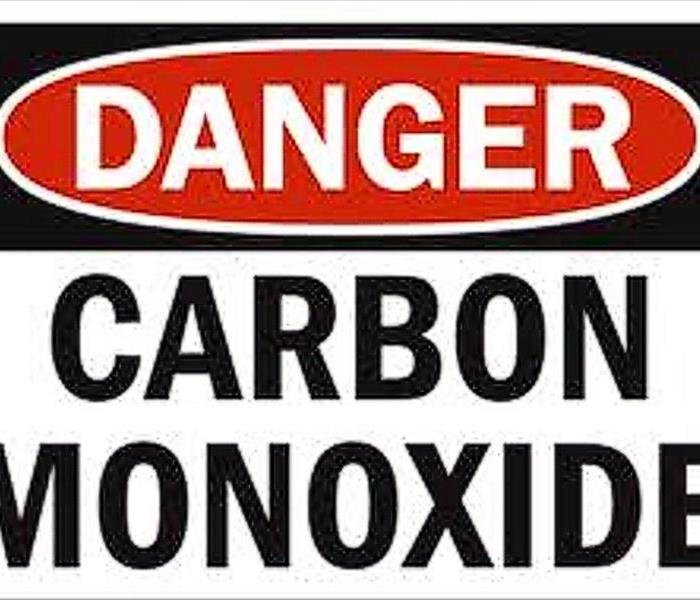 Know the signs of carbon monoxide poisoning.
Know the signs of carbon monoxide poisoning.
There is always a risk of carbon monoxide poisoning in your home or business. There are various appliances and systems that could accidentally introduce carbon monoxide into your building, and cause poisoning. Household appliances, gas fires, boilers, central heating systems, water heaters, cookers, open fires that use gas, oil, coal and wood can all pose a risk. Carbon monoxide is a colorless, odorless, tasteless gas that can be very dangerous at high levels. It can be particularly dangerous for people who are sleeping or intoxicated.
Signs and symptoms of carbon monoxide poisoning may include:
- Dull headache
- Weakness
- Dizziness
- Nausea or vomiting
- Shortness of breath
- Confusion
- Blurred vision
- Loss of consciousness
If you feel you have been exposed with carbon monoxide poisoning, get into fresh air immediately and seek medical help. If you go to the hospital, they may have you breathe pure oxygen through a mask. This helps oxygen reach your organs and tissues.
Hyperbaric oxygen therapy may be used in cases of severe carbon monoxide poisoning. Hyperbaric oxygen therapy is air pressure that is about two or three times higher than normal. Hyperbaric oxygen therapy may be used in cases of severe carbon monoxide poisoning.
Hospital staff will need critical information as soon as you arrive. On the way to the hospital, try to prepare to answer questions about:
- Possible sources of carbon monoxide exposure
- Signs or symptoms, and when they started
- Any mental impairment, including confusion and memory problems
- Any loss of consciousness
- Other medical conditions with which the affected person has been diagnosed, including pregnancy
- Smoking habits
Carbon Monoxide
2/6/2019 (Permalink)
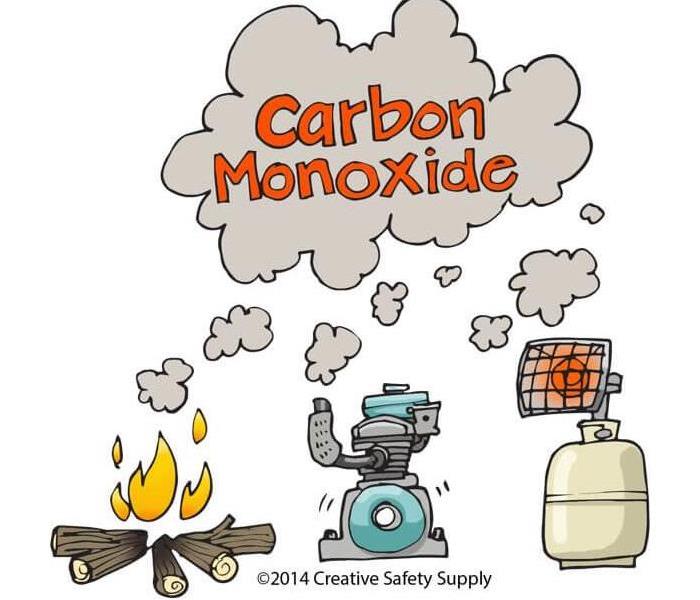 Know the signs of carbon monoxide poisoning.
Know the signs of carbon monoxide poisoning.
There is always a risk of carbon monoxide poisoning in your home or business. There are various appliances and systems that could accidentally introduce carbon monoxide into your building, and cause poisoning. Household appliances, gas fires, boilers, central heating systems, water heaters, cookers, open fires that use gas, oil, coal and wood can all pose a risk. Carbon monoxide is a colorless, odorless, tasteless gas that can be very dangerous at high levels. It can be particularly dangerous for people who are sleeping or intoxicated.
Signs and symptoms of carbon monoxide poisoning may include:
- Dull headache
- Weakness
- Dizziness
- Nausea or vomiting
- Shortness of breath
- Confusion
- Blurred vision
- Loss of consciousness
If you feel you have been exposed with carbon monoxide poisoning, get into fresh air immediately and seek medical help. If you go to the hospital, they may have you breathe pure oxygen through a mask. This helps oxygen reach your organs and tissues.
Hyperbaric oxygen therapy may be used in cases of severe carbon monoxide poisoning. Hyperbaric oxygen therapy is air pressure that is about two or three times higher than normal. Hyperbaric oxygen therapy may be used in cases of severe carbon monoxide poisoning.
Hospital staff will need critical information as soon as you arrive. On the way to the hospital, try to prepare to answer questions about:
- Possible sources of carbon monoxide exposure
- Signs or symptoms, and when they started
- Any mental impairment, including confusion and memory problems
- Any loss of consciousness
- Other medical conditions with which the affected person has been diagnosed, including pregnancy
- Smoking habits
Frying the Thanksgiving Turkey
11/20/2018 (Permalink)
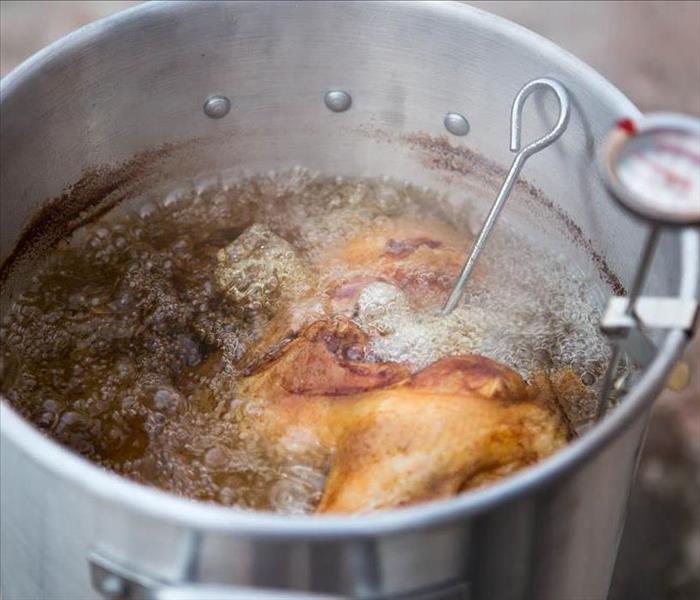 Frying the Thanksgiving Turkey
Frying the Thanksgiving Turkey
Thanksgiving is right around the corner, and the most popular traditional entrée is the turkey. There are two common types of cooking: roasting and deep-frying. According to FEMA, between 2014 and 2016 there were an estimated 2,400 residential building fires reported to fire departments in the U.S. on Thanksgiving Day. These caused an estimated 5 deaths, 25 injuries, and $19 million in property loss.
Deep-frying a turkey makes a delicious bird, but can be very dangerous. Here are a few tips on how to fry a turkey safely.
- Keep outdoor fryers off of decks, out of garages, and a safe distance away from trees and other structures.
- Make sure the turkey is fully-thawed and dry before cooking. Ice or water that mixes into the hot oil can cause flare-ups.
- Watch the weather. Never operate an outdoor fryer in the rain or snow.
- Place the fryer on a level surface, and avoid moving it once it is in use.
- Leave 2 feet between the tank and the burner when using a propane-powered fryer.
- Follow the manufacturer’s instructions to avoid overfilling. Oil can ignite when it makes contact with the burner.
- Choose a smaller turkey for frying. A bird that is 8 to 10 pounds is best. Avoid turkeys over 12 pounds.
- Never leave fryers unattended.
- Purchase a fryer with temperature controls and watch the oil temperature carefully. Cooking oil that is heated beyond its smoke point can catch fire. If you notice the oil is smoking, turn the fryer off.
- Turn off the burner before lowering the turkey into the oil. Once the turkey is submerged, turn the burner back on.
- Wear goggles to shield your eyes. Use oven mitts to protect your hands and arms, and keep an “ABC” or grease-rated fire extinguisher close by. Do not use water or a garden hose on a fryer oil fire.
- Skip the stuffing when frying turkey, and avoid water-based marinades.
- Keep children and pets away from the fryer at all times.
- Once finished, carefully remove the pot from the burner, place it on a level surface, and cover to let the oil cool overnight before disposing of it.
- Opt for an oil-less fryer. This uses infrared heat, rather than oil to cook the turkey
We hope these tips help so you have a happy and safe Thanksgiving.
Wild Fire Zones
7/25/2018 (Permalink)
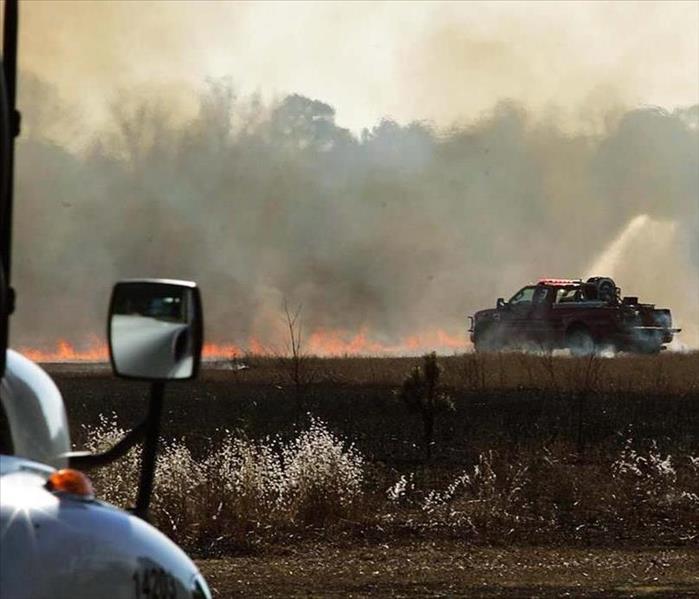 Field fire
Field fire
We have had a really wet spring this year, and that can mean two different things. On one hand, the trees, grass and shrubs are growing lush and green. But unfortunately in Casper, it does turn brown later in the season, and makes fuel for fire. There are many things that can start a wildland fire, anywhere from human irresponsibility to naturally-occurring events, such as lightning strikes. There are steps you can take to protect your home, whether you reside in the city, up in the mountains, or out on the Wyoming prairies. There are 3 types of defensive zones to help protect your home:
Zone 1
- Prune and maintain any plants to prevent excessive growth. Also, remove all dead branches, stems and leaves within and below the plant.
- Do not store firewood or other combustible materials anywhere in this zone. Keep firewood at least 30 feet away from structures, and uphill if possible.
- Remove any branches that overhang or touch the roof, and remove all fuelswithin 10 feet of the chimney.
- Remove all pine needles and other debris from the roof, deck and gutters.
- Rake pine needles and other organic debris at least 10 feet away from all decks and structures.
Zone 2
- Limit the number of dead trees (snags) to one or two per acre. Be sure snags cannot fall onto the house, power lines, roads or driveways.
- Small groups of two or three trees may be left in some areas of Zone 2, but leave a minimum of 30 feet between the crowns of these clumps and surrounding trees.
- Remove all ladder fuels from under remaining trees. Prune tree branches off the trunk to a height of 10 feet from the ground or 1/3 the height of the tree, whichever is less.
- Locate propane tanks and natural gas meters at least 30 feet from any structures, preferably on the same elevation as the house.
- The tank should not be located below your house because if it ignites, the fire would tend to burn uphill. Conversely, if the tank or meter is located above your house and it develops a leak, gas will flow downhill into your home.
- Do not visibly screen propane tanks or natural gas meters with shrubs, vegetation or flammable fencing. Instead, install 5 feet of nonflammable ground cover around the tank or meter.
Zone 3
- While tree pruning generally is not necessary, it may be a good idea from the standpoint of personal safety to prune trees along trails and firefighter access roads. Or, if you prefer the aesthetics of a well-manicured forest, you might prune the entire area. In any case, pruning helps reduce ladder fuels within tree stands, thus reducing the risk of crown fire.
- Remember to consider the hazards associated with ladder fuels. A forest with a higher canopy reduces the chance of a surface fire climbing into the tops of the trees, and might be a priority if this zone has steep slopes.
After Fire Tips
6/26/2018 (Permalink)
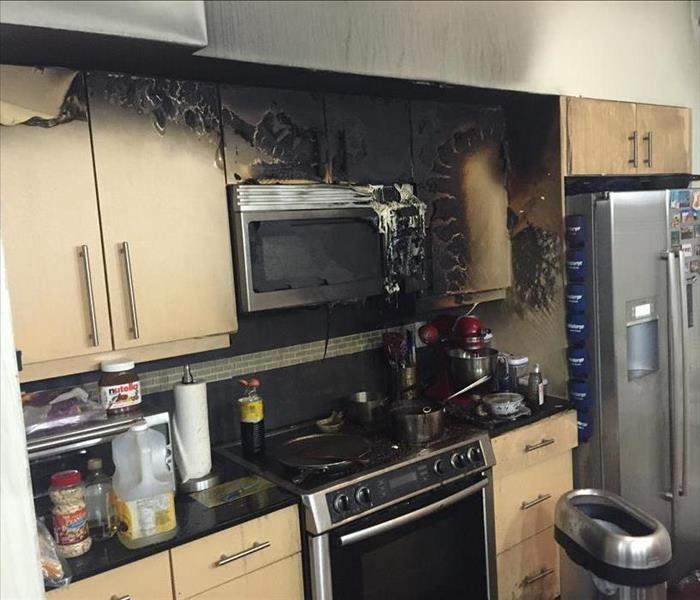 Fire/Smoke damage kitchen.
Fire/Smoke damage kitchen.
The aftermath of a fire can be chaotic and emotionally devastating. You may be concerned with the damage done to your property, and the business you’re likely to lose as a result of it. Although it can be difficult, it’s important to stop, take a deep breath, and prioritize what needs to be done. Follow these steps to help make sure your loss goes smoothly as possible.
- Contact Your Insurance Provider
It’s important to contact your insurance provider first, so that you can begin the process of filing a claim. Your provider will want to send a claims adjuster to assess the damage, and the sooner this can be scheduled, the sooner you will receive payment to pay for restoration services.
2. Secure Your Property
Fire can leave your building with large holes in the walls and ceilings, leaving the contents exposed to further damage. Your insurance will cover damages from the fire, but it won’t cover damage from rain and snow entering the building after the fire, or theft resulting from the building being easily accessible. - Document the Damage
Your insurance company will require evidence of your losses. Take photographs or videos of as much damage as you can without putting yourself in danger. It’s also good to compile a list of everything lost in the fire. If you have receipts or other documentation, start pulling these together.
4. Resist the Temptation To Clean Up
Although you may feel tempted to begin throwing things away or making repairs, don’t. It’s important that the claims adjuster has a chance to assess the original damage. It’s also better to let a fire restoration specialist assess your property before throwing it out. Items you believe to be destroyed by smoke damage may actually be salvageable through smoke cleaning.
If you experience a loss, give us a call. We will come out and discuss the process, on what we can and cannot do, and how to get started in the restoration process.
Safety grilling tips
4/16/2018 (Permalink)
 Grilling Season is here!!!!
Grilling Season is here!!!!
The weather is getting nicer, and the urge to grill is getting stronger. To make sure you have a safe grilling season, we will provide a list of safety precautions, such as how to check you gas lines before you start grilling and where to place your grill. Grilling is supposed to be fun and relaxing. Don't let one grilling mistake ruin your summer!
General grilling tips:
- Propane and charcoal BBQ grills should only be used outdoors.
- The grill should be placed well away from the home, deck railings and out from under eaves and overhanging branches.
- Keep children and pets away from the grill area.
- Keep your grill clean by removing grease or fat buildup from the grills and in trays below the grill.
- Never leave your grill unattended.
Before you use your grill:
Check the major connection points between the gas (propane) tank hose and the regulator and cylinder, and where the hose connects to the burners. Tighten if loose.
- Check the gas (propane) tank hose for potential gas leaks. To do that:
- Apply a light soap and water solution to the hose using a brush or spray bottle.
- Turn the propane tank on. If there is a gas leak, the propane will release bubbles around the hose (big enough to see).
- If there are no bubbles, your grill is safe to use.
- If there are bubbles, turn off the tank and check connections If the leaks continue, then have your grill serviced by a professional before using it again.
- If the leak doesn’t stop, call the fire department immediately.
When the grill is on:
- As you are cooking, if you smell gas, turn off the gas tank and burners.
- If the leak stops immediately, get the grill serviced by a professional before using it again.
- If the smell continues, move away from the grill and call the fire department immediately. Do not move the grill.
Charcoal grills
- There are several ways to get the charcoal ready to use. Charcoal chimney starters allow you to start the charcoal using newspaper as a fuel.
- If you use a starter fluid, use only charcoal starter fluid. Never add charcoal fluid or any other flammable liquids to the fire once it starts burning.
- Keep charcoal fluid out of the reach of children and away from heat sources.
- There are also electric charcoal starters, which do not use an open flame. Be sure to use an extension cord rated for outdoor use.
- When you are finished grilling, let the coals completely cool before disposing in a metal container.
By following these steps this will help you have a safe and happy grilling season.
Smoke Detectors
1/23/2018 (Permalink)
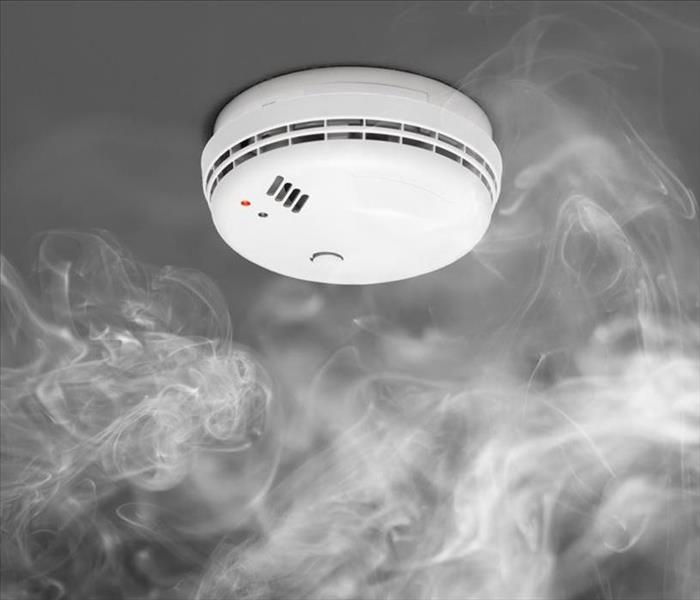 Smoke detectors will help save lives.
Smoke detectors will help save lives.
Whether you’re at home, a hotel, or on a cruise ship, smoke detectors are important to you and your loved ones. They give residents peace of mind, and it helps get people out safely in the event of a fire or smoke emergency.
If they aren’t properly maintained, they can become a nuisance, beeping when the batteries are low. The constant beeping can drive you and others crazy. And they become unreliable in this low-power state.
Here are some quick tips to help keep your smoke detectors in good working order, and your family protected:
- At least one smoke detector should be installed on every level of your home, but it’s best to have one in each bedroom.
- Change the batteries once a year. Changing your batteries in the spring when you do your spring cleaning or on New Year’s Day is easy to remember.
- If you replaced the batteries (and you're sure the batteries are fresh) and your alarm is receiving power but it still won't stop chirping, the detector probably needs to be reset. Disconnect it from the ceiling, remove the battery, and press and hold the test button for 15-20 seconds. The unit should beep several times, and stop. Put the battery back in and reconnect the detector to your ceiling or wall.
- Test your smoke detectors once a month.
- If the alarm doesn't sound when you press the test button, try pressing and holding for 10-20 seconds. If it still doesn't work, the battery could be loose, or your AC or power may not be on (check that the red or green light is continuously lit).
- Make note of your smoke detector install and/or expiration date.
- Alarms don't last forever: the average lifespan of a smoke detector is 10 years. If you aren't sure when it was installed, replace it immediately.
If you end up with smoke damage in your home, SERVPRO of Casper is always here to help.
Holiday Decoration Safety Tips In Casper, WY
12/12/2017 (Permalink)
 Holiday Decorations
Holiday Decorations
With the holiday season, we all get excited about the cooking, baking, and setting up Christmas decorations. But unfortunately, with all the excitement we become complacent, and we don’t think of safety first.
According to the US Consumer Product Safety Commission there were 15,000 injuries related to holiday decorations in 2012. Mishaps send about 250 people to the emergency room daily, with falls, cuts and back strains topping the list of injuries. To ensure you have a safe, healthy, and happy holiday season with your friends and family, here are 12 tips to keep in mind as you deck out your home:
- Keep live trees away from heated sources – Keep your tree from heated sources such as fireplaces and heaters. It’s a good idea to keep a fire extinguisher near your tree. Live trees are highly flammable because of the needles and sap.
- Hydrate your tree - When picking your tree you want to pick the greenest one. It’s one way to keep your tree from drying out so quickly. Make sure you check it every other day to make sure the water does not run out. A dried out tree is more flammable then a hydrated one.
- Artificial tree - When purchasing an artificial tree you want to make sure that it’s labeled “fire resistant.” Artificial trees that are fire resistant have a low chance of catching on fire.
- Burning wrapping paper in the fireplace - Paper can catch fire very quickly and cause a flash fire.
- Work as a team - When stringing lights and decorations higher than you can reach, make sure you use a proper ladder and someone supporting the base.
- Double check your lights - Check and replace any lights that may have frayed wires, broken sockets, and loose connections. Make sure you don’t put indoor-rated lights outside; you want to check the label to see if they are designed to be hung outdoors. You want to make sure that you don’t string too many lights together so you don’t over strain the cords and cause a fire.
- Power down at the end of the night – Turn off all your lights before going to bed. It’s also a good idea to do that before you leave your home. In case of an electrical short, you can avoid significant damage when caught in time.
- Prevent electrical cord damage – Don’t mount electrical cords in areas that are at a high risk of crimping or damaging the cord. When hanging them, make sure you use hooks or insulated staples instead of nails or tacks.
- Secure candles – When buying candles, it is best to buy them in a glass container with a lid. Make sure candles are placed on a sturdy platform to help prevent tipping. Always snuff out the candles before leaving your home or going to bed.
- Use unbreakable ornaments – If you have fragile ornaments, place them out of reach of pets and kids.
- Fake food – It’s best to avoid artificial candy or food around pets and children.
- Poisonous plants – Poinsettias are poisonous when eaten, so it’s a good idea to keep them out of reach of kids and pets.
Happy Holidays from all of us at SERVPRO of Casper!
Smoke Damage
12/12/2017 (Permalink)
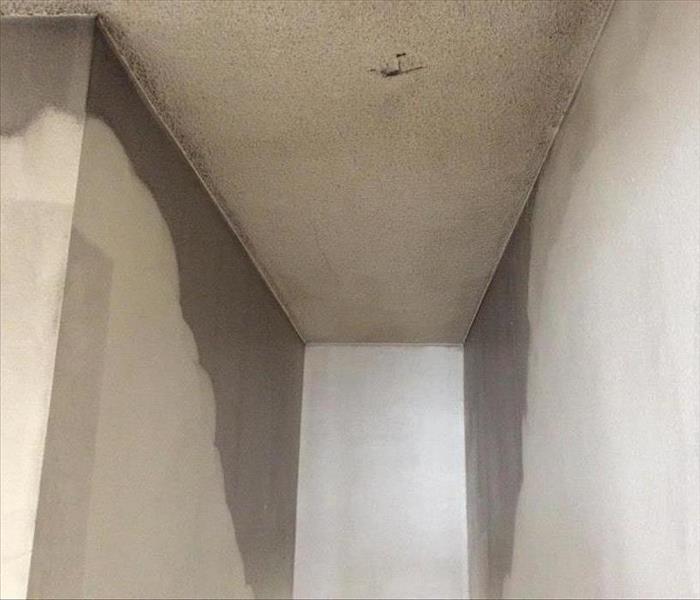 Smoke Damage in Casper, WY
Smoke Damage in Casper, WY
Smoke has many interesting characteristics, such as where it travels and how easily it is able to penetrate materials. It’s fascinating to learn the different types of smoke and what materials cause it, and the different kinds of cleaning methods necessary for each type. SERVPRO has many different tools, cleaning products, and deodorization methods that are specifically designed to target each type of smoke. Our technicians know which type of product to use, and how to address the little particles of smoke that hide in cracks, corners, and crevices.
SERVPRO of Casper’s trained technicians are experienced in identifying what type of smoke is present, what cleaning method is best for the situation, and what needs to be cleaned. Through the years we have had calls from many customers that have attempted to do the cleaning themselves, They found that smoke cleanup is very challenging, and best left to the professionals for effective restoration. Customers don’t realize all the little stuff that needs cleaned and the areas that are easily missed. They don’t have access to professional smoke removal products, and the deodorization tools to make sure the problem is fully and properly corrected.
The different types of smoke:
Wet Smoke: (Plastics and Rubber materials)
Low heat, smoldering, pungent odor, sticky, smeary. Wet smoke has become more common, as we have ever-increasing amounts of plastic items in our homes. These residues are best cleaned up using “wet” methods, such as liquid cleaners. Pre-deodorizing this type of smoke damage with thermal fogging can aid greatly in the cleaning.
Dry Smoke: (Paper and Wood materials)
Fast burning, high temperatures, fine, dry particles. “Dry” cleanup methods, such as dry-clean sponges, are typically used to remove most of this smoke. Sometimes, additional wet cleaning needs to be done if the smoke is heavily-concentrated.
Protein Fire Residue: (Protein Foods Meats and Beans)
Discolors paints, and varnishes, extreme pungent odor. This is the most difficult type of smoke to effectively deodorize. Wet-cleaning with grease-cutting additives is necessary. Multiple methods of deodorization, including activated oxygen (ozone) are also necessary.
Fuel Oil Soot: (Furnace Puff Backs)
Fuel-oil furnaces are rare in Wyoming, so puff-backs do not occur often. Cleanup of this type of smoke requires special products to break down the oily residue. In most cases, we can restore the contents and structure quickly.
Other Types: Tear Gas, Fingerprint Powder, Fire Extinguisher Dust)
Each particular loss requires special care. SERVPRO technicians understand how to identify these specialty residues, and remediate them on a case-by-case basis.
If you should have smoke damage in your home or business, call SERVPRO of Casper today. We will assess the damage, and develop a plan to restore your property quickly and effectively.
Casper, Wyoming Smoke and Soot Cleanup
6/7/2016 (Permalink)
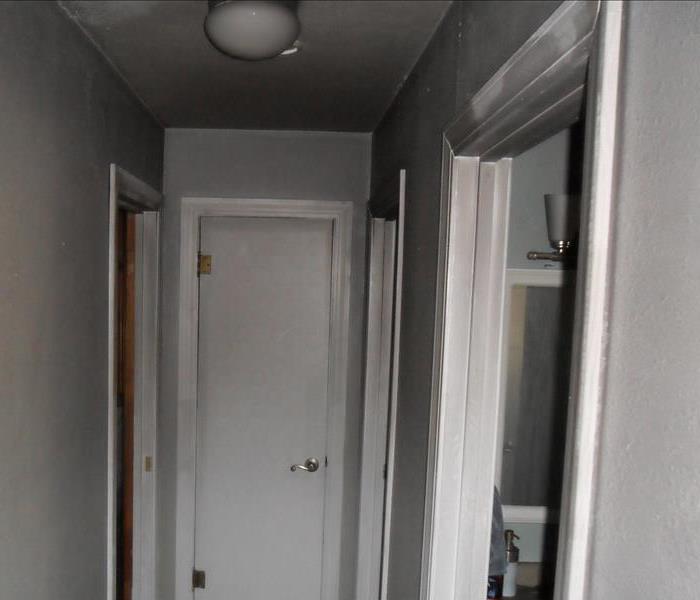 Smoke and Soot Damage Can Cause a Pervasive Odor in Your Casper Home.
Smoke and Soot Damage Can Cause a Pervasive Odor in Your Casper Home.
Smoke and soot is very invasive and can penetrate various cavities within your home, causing hidden damage and odor. Our smoke damage expertise and experience allows us to inspect and accurately assess the extent of the damage to develop a comprehensive plan of action.
Smoke and soot facts:
· Hot smoke migrates to cooler areas and upper levels of a structure.
· Smoke flows around plumbing systems, seeping through the holes used by pipes to go from floor to floor.
· The type of smoke may greatly affect the restoration process.
Different Types of Smoke
There are two different types of smoke–wet and dry. As a result, there are different types of soot residue after a fire. Before restoration begins, SERVPRO of Casper will test the soot to determine which type of smoke damage occurred. The cleaning procedures will then be based on the information identified during pretesting. Here is some additional information:
Wet Smoke – Plastic and Rubber
· Low heat, smoldering, pungent odor, sticky, smeary. Smoke webs are more difficult to clean.
Dry Smoke – Paper and Wood
· Fast burning, high temperatures, heat rises therefore smoke rises.
Protein Fire Residue – Produced by evaporation of material rather than from a fire
· Virtually invisible, discolors paints and varnishes, extreme pungent odor.
Our Fire Damage Restoration Services
Since each smoke and fire damage situation is a little different, each one requires a unique solution tailored for the specific conditions. We have the equipment, expertise, and experience to restore your fire and smoke damage. We will also treat your family with empathy and respect and your property with care.
Have Questions about Fire, Smoke, or Soot Damage?
Call Us Today – 307-235-6558




 24/7 Emergency Service
24/7 Emergency Service






























